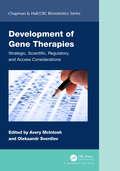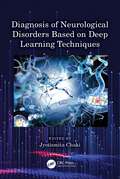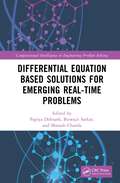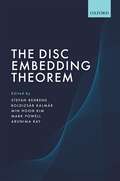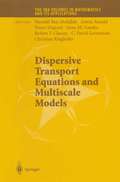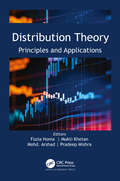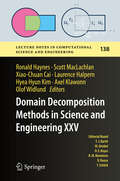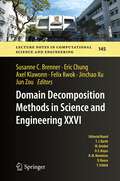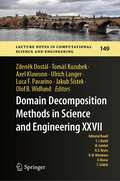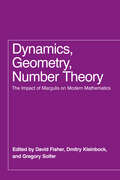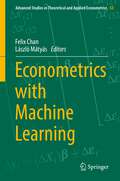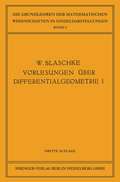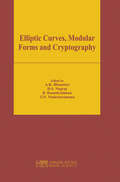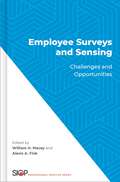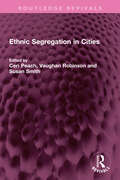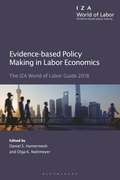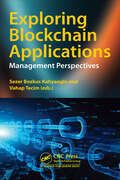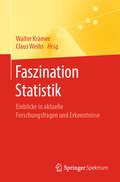- Table View
- List View
Development of Gene Therapies: Strategic, Scientific, Regulatory, and Access Considerations (Chapman & Hall/CRC Biostatistics Series)
Cell and gene therapies have become the third major drug modality in pharmaceutical medicine of the 21st century after low molecular weight and antibody drugs. The gene therapy (GTx) field is rapidly advancing, and yet there are still fundamental scientific questions that remain to be answered. Development of GTx products poses unique challenges and opportunities for drug developers. However, there is lack of a systematic exposition of the GTx product development and the pivotal role of the biostatistician in this process. Development of Gene Therapies: Strategic, Scientific, and Regulatory, and Access Considerations attempts to summarize the current state-of-the-art strategic, scientific, statistical, and regulatory aspects of GTx development. Intended to provide an exposition to the GTx new product development through peer-reviewed papers written by subject matter experts in this emerging field, this book will be useful for researchers in gene therapy drug development, biostatisticians, regulators, patient advocates, graduate students, and the finance and business development community . Key Features: A collection of papers covering a wide spectrum of topics in gene therapies (GTx), written by leading subject matter experts. An exposition of the core principles of GTx product development, emerging business models, industry standards, best practices, and regulatory pathways. An exposition of statistical and innovative modeling tools for design and analysis of clinical trials of GTx. Insights into commercial models, access hurdles, and health economics of gene therapies. Case studies of successful GTx approvals from core team members that developed the first two FDA-approved AAV gene therapies: Luxturna and Zolgensma. A discussion of potential benefits and hurdles to be overcome for GTx in coming years from a multi-stakeholder perspective.
Diagnosis of Neurological Disorders Based on Deep Learning Techniques
This book is based on deep learning approaches used for the diagnosis of neurological disorders, including basics of deep learning algorithms using diagrams, data tables, and practical examples, for diagnosis of neurodegenerative and neurodevelopmental disorders. It includes application of feed-forward neural networks, deep generative models, convolutional neural networks, graph convolutional networks, and recurrent neural networks in the field of diagnosis of neurological disorders. Along with this, data preprocessing including scaling, correction, trimming, and normalization is also included. Offers a detailed description of the deep learning approaches used for the diagnosis of neurological disorders. Demonstrates concepts of deep learning algorithms using diagrams, data tables, and examples for the diagnosis of neurodegenerative, neurodevelopmental, and psychiatric disorders. Helps build, train, and deploy different types of deep architectures for diagnosis. Explores data preprocessing techniques involved in diagnosis. Includes real-time case studies and examples. This book is aimed at graduate students and researchers in biomedical imaging and machine learning.
Differential Equation Based Solutions for Emerging Real-Time Problems (Computational Intelligence in Engineering Problem Solving)
Modeling with differential equations is an effective tool to provide methodical and quantitative solutions to real-world phenomena including investigating measurable features, consolidation and processing of data, and designing and developing complex engineering systems. This book describes differential equations correlation with qualitative and quantitative analysis, and mathematical modeling in the engineering and applied sciences. Given equations are explained from multidimensional characterizations with MATLAB® codes. Features: Addresses differential equation-based approaches to solve varied engineering problems. Discusses derivation and solution of major equations of engineering and applied science. Reviews qualitative and quantitative (numerical) analysis and mathematical modelling. Includes mathematical models of the discussed problems. Discusses MATLAB® codes. Features: code and online materials related to the differential equations. This book is aimed at researchers graduate students in electrical and electronics engineering, control systems, electron devices society, applied physics, and engineering design.
Differential Equations on Manifolds and Mathematical Physics: Dedicated to the Memory of Boris Sternin (Trends in Mathematics)
This is a volume originating from the Conference on Partial Differential Equations and Applications, which was held in Moscow in November 2018 in memory of professor Boris Sternin and attracted more than a hundred participants from eighteen countries. The conference was mainly dedicated to partial differential equations on manifolds and their applications in mathematical physics, geometry, topology, and complex analysis.The volume contains selected contributions by leading experts in these fields and presents the current state of the art in several areas of PDE. It will be of interest to researchers and graduate students specializing in partial differential equations, mathematical physics, topology, geometry, and their applications. The readers will benefit from the interplay between these various areas of mathematics.
The Disc Embedding Theorem
Based on Fields medal winning work of Michael Freedman, this book explores the disc embedding theorem for 4-dimensional manifolds. This theorem underpins virtually all our understanding of topological 4-manifolds. Most famously, this includes the 4-dimensional Poincaré conjecture in the topological category. The Disc Embedding Theorem contains the first thorough and approachable exposition of Freedman's proof of the disc embedding theorem, with many new details. A self-contained account of decomposition space theory, a beautiful but outmoded branch of topology that produces non-differentiable homeomorphisms between manifolds, is provided, as well as a stand-alone interlude that explains the disc embedding theorem's key role in all known homeomorphism classifications of 4-manifolds via surgery theory and the s-cobordism theorem. Additionally, the ramifications of the disc embedding theorem within the study of topological 4-manifolds, for example Frank Quinn's development of fundamental tools like transversality are broadly described. The book is written for mathematicians, within the subfield of topology, specifically interested in the study of 4-dimensional spaces, and includes numerous professionally rendered figures.
Dispersive Transport Equations and Multiscale Models (The IMA Volumes in Mathematics and its Applications #136)
IMA Volumes 135: Transport in Transition Regimes and 136: Dispersive Transport Equations and Multiscale Models focus on the modeling of processes for which transport is one of the most complicated components. This includes processes that involve a wdie range of length scales over different spatio-temporal regions of the problem, ranging from the order of mean-free paths to many times this scale. Consequently, effective modeling techniques require different transport models in each region. The first issue is that of finding efficient simulations techniques, since a fully resolved kinetic simulation is often impractical. One therefore develops homogenization, stochastic, or moment based subgrid models. Another issue is to quantify the discrepancy between macroscopic models and the underlying kinetic description, especially when dispersive effects become macroscopic, for example due to quantum effects in semiconductors and superfluids. These two volumes address these questions in relation to a wide variety of application areas, such as semiconductors, plasmas, fluids, chemically reactive gases, etc.
Distribution Theory: Principles and Applications
This book provides a thorough understanding of distribution theory and data analysis using statistical software to solve problems related to basic statistics, probability models, and simulation. It presents a detailed explanation of different distribution concepts used in statistics along with their application in real-life situations. Covering the analytical aspects using the latest software, the volume discusses stochastic methods and other statistical methods. It provides an overview of statistical data analysis by taking actual situations and implementing open-source software R version 4.0 and Python 3.0+. A detailed study of the statistical models is also provided with examples related to health, agriculture, insurance, and other sectors.
Domain Decomposition Methods in Science and Engineering XXV (Lecture Notes in Computational Science and Engineering #138)
These are the proceedings of the 25th International Conference on Domain Decomposition Methods in Science and Engineering, which was held in St. John's, Newfoundland, Canada in July 2018. Domain decomposition methods are iterative methods for solving the often very large systems of equations that arise when engineering problems are discretized, frequently using finite elements or other modern techniques. These methods are specifically designed to make effective use of massively parallel, high-performance computing systems. The book presents both theoretical and computational advances in this domain, reflecting the state of art in 2018.
Domain Decomposition Methods in Science and Engineering XXVI (Lecture Notes in Computational Science and Engineering #145)
These are the proceedings of the 26th International Conference on Domain Decomposition Methods in Science and Engineering, which was hosted by the Chinese University of Hong Kong and held online in December 2020.Domain decomposition methods are iterative methods for solving the often very large systems of equations that arise when engineering problems are discretized, frequently using finite elements or other modern techniques. These methods are specifically designed to make effective use of massively parallel, high-performance computing systems.The book presents both theoretical and computational advances in this domain, reflecting the state of art in 2020.
Domain Decomposition Methods in Science and Engineering XXVII (Lecture Notes in Computational Science and Engineering #149)
These are the proceedings of the 27th International Conference on Domain Decomposition Methods in Science and Engineering, which was held in Prague, Czech Republic, in July 2022.Domain decomposition methods are iterative methods for solving the often very large systems of equations that arise when engineering problems are discretized, frequently using finite elements or other modern techniques. These methods are specifically designed to make effective use of massively parallel, high-performance computing systems.The book presents both theoretical and computational advances in this domain, reflecting the state of art in 2022.
Dynamics, Geometry, Number Theory: The Impact of Margulis on Modern Mathematics
This definitive synthesis of mathematician Gregory Margulis’s research brings together leading experts to cover the breadth and diversity of disciplines Margulis’s work touches upon. This edited collection highlights the foundations and evolution of research by widely influential Fields Medalist Gregory Margulis. Margulis is unusual in the degree to which his solutions to particular problems have opened new vistas of mathematics; his ideas were central, for example, to developments that led to the recent Fields Medals of Elon Lindenstrauss and Maryam Mirzhakhani. Dynamics, Geometry, Number Theory introduces these areas, their development, their use in current research, and the connections between them. Divided into four broad sections—“Arithmeticity, Superrigidity, Normal Subgroups”; “Discrete Subgroups”; “Expanders, Representations, Spectral Theory”; and “Homogeneous Dynamics”—the chapters have all been written by the foremost experts on each topic with a view to making them accessible both to graduate students and to experts in other parts of mathematics. This was no simple feat: Margulis’s work stands out in part because of its depth, but also because it brings together ideas from different areas of mathematics. Few can be experts in all of these fields, and this diversity of ideas can make it challenging to enter Margulis’s area of research. Dynamics, Geometry, Number Theory provides one remedy to that challenge.
Econometrics with Machine Learning (Advanced Studies in Theoretical and Applied Econometrics #53)
This book helps and promotes the use of machine learning tools and techniques in econometrics and explains how machine learning can enhance and expand the econometrics toolbox in theory and in practice. Throughout the volume, the authors raise and answer six questions: 1) What are the similarities between existing econometric and machine learning techniques? 2) To what extent can machine learning techniques assist econometric investigation? Specifically, how robust or stable is the prediction from machine learning algorithms given the ever-changing nature of human behavior? 3) Can machine learning techniques assist in testing statistical hypotheses and identifying causal relationships in ‘big data? 4) How can existing econometric techniques be extended by incorporating machine learning concepts? 5) How can new econometric tools and approaches be elaborated on based on machine learning techniques? 6) Is it possible to develop machine learning techniques further and make them even more readily applicable in econometrics?As the data structures in economic and financial data become more complex and models become more sophisticated, the book takes a multidisciplinary approach in developing both disciplines of machine learning and econometrics in conjunction, rather than in isolation. This volume is a must-read for scholars, researchers, students, policy-makers, and practitioners, who are using econometrics in theory or in practice.
Edwin A. Abbotts Flachland: Eine Ausgabe mit Anmerkungen und Kommentar (Mathematik im Kontext)
Edwin A. Abbotts Flachland erzählt auf humorvolle Weise die Geschichte einer zweidimensionalen Welt aus der Sicht eines Quadrats, das in die Mysterien des dreidimensionalen Raums eingeweiht wird. Die vorliegende Neuübersetzung des Romans von 1884 wird durch einen durchgängigen Kommentar ergänzt, der auf der 2010 bei Cambridge University Press erschienenen Ausgabe von William Lindgren und Thomas Banchoff basiert. Damit liegt zum ersten Mal in deutscher Sprache eine ausführlich annotierte Ausgabe des Klassikers vor sowie eine Übersetzung, welche die vielen Dimensionen des Werkes berücksichtigt. Die bereits im Untertitel des englischen Originals – a romance of many dimensions – angekündigte Mehrdimensionalität prägt Abbotts Werk nicht nur in einem rein mathematischen Sinne. Zwar kann der satirische Roman als Einführung in die Geometrie höherer Dimensionen gelesen werden, er ist jedoch auch reich an Anspielungen auf die Werke Platons, Shakespeares, auf die Bibel, auf andere Werke des Autors sowie auf zeitgenössische Themen des viktorianischen Englands. In diesen vielschichtigen Bezugnahmen übt Abbott Kritik an den Normvorstellungen seiner Zeit. Zugleich bleibt das Werk auch heute hochaktuell, spricht es doch Themen an wie Klassismus, Sexismus, Ableismus sowie jegliche Diskriminierung aufgrund von vermeintlichem Anders-Sein. So ist Flachland eine unterhaltsame Gesellschaftskritik und zudem eine außergewöhnliche literarische Auseinandersetzung mit der Einsicht, dass Wahrnehmung immer von den jeweiligen Annahmen darüber abhängt, was grundsätzlich wahrnehmbar sei. Die damit verbundenen ‚dimensionalen Vorurteile‘ zu hinterfragen, dazu lädt Abbotts Flachland auch eineinhalb Jahrhunderte nach seinem Erscheinen immer wieder ein.“We thank Mirjam Rabe for her excellent translation of, as well as additions and corrections to, our notes and commentary. We believe that Abbott would be pleased with her elegant translation of his beautiful prose.” William F. Lindgren, Thomas F. Banchoff
Elementare Differentialgeometrie (Grundlehren der mathematischen Wissenschaften #1)
Dieser Buchtitel ist Teil des Digitalisierungsprojekts Springer Book Archives mit Publikationen, die seit den Anfängen des Verlags von 1842 erschienen sind. Der Verlag stellt mit diesem Archiv Quellen für die historische wie auch die disziplingeschichtliche Forschung zur Verfügung, die jeweils im historischen Kontext betrachtet werden müssen. Dieser Titel erschien in der Zeit vor 1945 und wird daher in seiner zeittypischen politisch-ideologischen Ausrichtung vom Verlag nicht beworben.
Elliptic Curves, Modular Forms and Cryptography: Proceedings of the Advanced Instructional Workshop on Algebraic Number Theory
Employee Surveys and Sensing: Challenges and Opportunities (The Society for Industrial and Organizational Psychology Professional Practice Series)
Professional practice in the design and execution of employee survey programs has evolved tremendously over the past decade. Advances in technology and enthusiastic new interest in talent analytics have combined to create an exciting space with a good deal of innovation along methodological lines, matched by renewed interest in the strategic role of surveys and sensing for improving organizational effectiveness. Providing solid grounding in the basic issues of content development, interpreting results, and driving action, this book also addresses cutting-edge topics in the area of survey analytics (including applications of computational linguistics and artificial intelligence). Significant emphasis is given to ethical issues which are particularly salient given the zeitgeist for ensuring the protection of data and the privacy of survey respondents. The book is appropriate for use in advanced graduate level courses in survey research and will be a valuable shelf resource for survey practitioners whether trained formally in I-O psychology or other areas of organizational science.
Enlargement
This diagram shows two triangles; the original triangle and its enlargement into a new position. A locator dot and title are shown. These must always be at the top left of the page when the image is the right way up. There is a graph with the x-axis ranging from 0 to 5 at the bottom of the page. The y-axis ranging from 0 to 6 is to the left. Every other axis division mark is labelled. Some of the braille uses maths code notation. The original triangle is in the centre of the diagram. The enlarged triangle is towards the bottom right. The heavy dotted lines indicate the tracking of the enlargement. A1B1 = 2 x AB therefore the scale factor is 2.
Enlargement
This diagram shows two triangles; the original triangle and its enlargement into a new position. A locator dot and title are shown. These must always be at the top left of the page when the image is the right way up. There is a graph with the x-axis ranging from 0 to 5 at the bottom of the page. The y-axis ranging from 0 to 6 is to the left. Every other axis division mark is labelled. Some of the braille uses maths code notation. The original triangle is in the centre of the diagram. The enlarged triangle is towards the bottom right. The heavy dotted lines indicate the tracking of the enlargement. A1B1 = 2 x AB therefore the scale factor is 2.
Enlargement
This diagram shows two triangles; the original triangle and its enlargement into a new position. A locator dot and title are shown. These must always be at the top left of the page when the image is the right way up. There is a graph with the x-axis ranging from 0 to 5 at the bottom of the page. The y-axis ranging from 0 to 6 is to the left. Every other axis division mark is labelled. Some of the braille uses maths code notation. The original triangle is in the centre of the diagram. The enlarged triangle is towards the bottom right. The heavy dotted lines indicate the tracking of the enlargement. A1B1 = 2 x AB therefore the scale factor is 2.
Entschleunigung: Die Entdeckung der Langsamkeit GLOBArt Academy 2008 (GLOBArt)
Die GLOBArt Academy 2008 befasste sich mit dem Thema „Entschleu- gung – die Entdeckung der Langsamkeit“. Das Kloster Pernegg – als Ort der Stille, der inneren Einkehr und der Kraft – erscheint ganz besonders geeignet, ein derartiges Thema im Kreis von Menschen aus vielfältigen - rufs- und Bildungsgruppen zu erarbeiten. In einer Zeit der exzessiven - tonung des Materiellen, rasanter (Fehl-)entwicklungen der Finanzmärkte und unübersehbar negativer Entwicklungen auf den Realmärkten und im Arbeitsmarkt verlieren wir alle leicht die Orientierung hin zu jenen W- ten und Lebensgrundlagen die das wirklich wesentliche Thema des Lebens ausmachen und die man nur mit innerer Gelassenheit zu entdecken v- mag. Werte, die also auch außerhalb des ?üchtigen Zeitbegriffes stehen: Tempus Fugit Gottes Mühlen mahlen langsam Die Zeit rettet die Wahrheit In zahlreichen Spruchweisheiten wird unser Generalthema in vielen K- turen in Gegenwart und Vergangenheit beschrieben. Jede Befassung mit dem Zeitbegriff ist eine Befassung mit der eigenen Endlichkeit und der uns unbegrei?ichen Unendlichkeit. Tempo und Langsamkeit, Beschleunigung und Entschleunigung sind T- men dieser irdischen begrenzten Zeitlichkeit. Es geht um die Auseinand- setzung mit tausenden auf uns einstürmenden Informationen und daraus permanent umgestürzten Prioritäten unseres täglichen Handelns und Ag- rens. Ein von Zwängen bestimmtes – in enge zeitliche Korsette gezwängtes passives Nebeneinander an Stelle eines aktiven Miteinanders. Konzentr- ren auf wirklich Wesentliches, das in der uns zur Verfügung stehenden Zeit positiv bewältigt und erlebt werden kann.
Ethnic Segregation in Cities (Routledge Revivals)
First published in 1981, Ethnic Segregation in Cities argues that race and ethnicity are fundamental to writing about the city, and that economic patterns adapt themselves to race and ethnicity rather than vice versa. The problem of ethnic segregation is a burning one for both geographers and sociologists – geographers because of the concern for all aspects of urban deprivation, and sociologists because they are discovering that space and spatial processes are important factors in influencing social segregation or assimilation. The book brings together some of the main contributors to the literature on spatial aspects of ethnicity from both sides of the Atlantic. A variety of evidence from New York, Detroit, Bradford and Blackburn address the question of whether choice on the path of ethnic members, or constraints imposed by the host society are determinant factors influencing residential segregation. This book will be of interest to students of sociology, human geography and urban studies.
Evidence-based Policy Making in Labor Economics: The IZA World of Labor Guide 2018
IZA World of Labor provides a reliable and concise guide to the best thinking and research on labor economics for decision makers, advisors, and interested citizens concerned with labor market issues worldwide.Written by well-known labor economists, this volume presents research findings on key policy issues in a compact and readable format, as distillations of comprehensive evidence-based research with concise policy recommendations. Designed to act as a quick reference, this guide brings together summaries of over 100 articles published on the IZA World of Labor website to give busy policy advisors, journalists, researchers, policymakers and concerned citizens in every country around the world instant access to authoritative guidance on key policy topics. These include summaries of the current state of specific country labor markets; the effects of climate change; part-time employment; multiple job-holding; motherhood wage penalty; big data; and labor market outcomes of trans people.
Exploring Blockchain Applications: Management Perspectives
In this book, the development process of blockchain algorithms and examples of their applications in different sectors are explored. The opportunities and challenges of blockchain implementations that arise in making technological innovations usable in corporate structures are discussed. In this respect, the book aims to deal with both the conceptual framework and the real challenges and opportunities encountered in practice regarding the blockchain applications. It is tried to contribute to the literature by presenting practical blockchain application suggestions to the readers on a scientific basis.It is a fact that blockchain technology is considered one of the most disruptive and revolutionary innovations after the invention of the internet. Blockchain technology, which was first used for cross-border payments, is coming up with a new application area in a different sector every day. The main purpose of Blockchain-based systems is to spread the "trust" service provided by a central intermediary to machines in transactions between two parties. Thus, it removes the need for this trust from the monopoly of a single intermediary. Blockchain implementation scenarios are to establish math-based trust in an untrusted environment.While exploring the complexity of blockchain applications in different sectors, the emerging risks are also examined from a management perspective. In particular, it is aimed to be a key work that the management levels of the enterprises can benefit from in the decision-making processes.It will be seen that blockchain technologies will be used unlimitedly in design, planning, management and decision making. This book will also introduce new visions for practitioners to use different blockchain technologies and methodologies to face problems.
Faszination Statistik: Einblicke in aktuelle Forschungsfragen und Erkenntnisse
Dieser Sammelband zeigt an ausgewählten Beispielen, wie spannend und vielfältig statistische Forschung sein kann. Ob es nun darum geht, hörgeschädigten Menschen einen guten Musikgenuss zu verschaffen, aus Texten sinnvolle quantitative Daten zu extrahieren oder Überschwemmungskatastrophen zu modellieren und damit besser in den Griff zu bekommen – die meisten in diesem Buch dargestellten Erkenntnisse sind nicht in Lehrbüchern zu finden, sie stammen direkt von der Forschungsfront und laden zum Staunen und Entdecken ein. Auf Fachjargon und Formalismus wird bei der Darstellung so weit wie möglich verzichtet – das Buch richtet sich somit an jeden, der sich für das aktuelle Forschungsgeschehen im Bereich statistischer Anwendungen interessiert. Es ermöglicht einen unverdeckten Blick auf eine durch und durch faszinierende Wissenschaft – ohne dass die einzelnen Analysen bis ins Detail nachvollzogen werden müssen. Studierenden kann das Buch helfen, Begeisterung für statistische Fragestellungen und Methoden zu entwickeln, oder sogar Anregungen für die eigene Laufbahn geben. Ein Großteil der Beiträge entstand an der Fakultät Statistik der TU Dortmund, der einzigen eigenständigen Statistik-Fakultät im ganzen deutschen Sprachgebiet, sowie darüber hinaus im Rahmen von an diese Fakultät angedockten DFG-Sonderforschungsbereichen.
Felix Klein und Georg Pick: Mathematische Talente fordern und fördern
Das Buch enthält die Vorträge, die der aus jüdischem Elternhaus in Wien stammende Mathematiker Georg Pick in Felix Kleins Forschungsseminaren in Leipzig (1883/84 und 1884 ) hielt, sowie die Briefe und Karten, die Pick von 1884 bis 1898 an Klein schrieb. Diese Dokumente werden kommentiert und mit einer ausführlichen Einleitung versehen. Es wird erhellt, wie Klein mathematische Talente erkannte, forderte und förderte. Die Quellen beleuchten den von Klein ausgeübten kooperativen Stil mathematischen Arbeitens, der sich damals gerade erst herausbildete und an manchen Orten noch verpönt war. Die Vorträge und Briefe dokumentieren Georg Picks kreative mathematische Ideen, bieten neue Einsichten zur frühen Geschichte der elliptischen Modulfunktionen und verwandter Gebiete. Außerdem wird deutlich, mit welchem Engagement Klein die Karriere Georg Picks förderte - in einer Zeit des weit verbreiteten Antisemitismus. Das Buch ist nützlich für Lehrende und Forschende in Mathematik, Mathematikunterricht und Wissenschaftsgeschichte.
